
Horse grooming
Encyclopedia

Horse care
There are many aspects to horse care. Horses, ponies, mules, donkeys and other domesticated equids require attention from humans for optimal health and long life.-Living environment:...
given to a horse
Horse
The horse is one of two extant subspecies of Equus ferus, or the wild horse. It is a single-hooved mammal belonging to the taxonomic family Equidae. The horse has evolved over the past 45 to 55 million years from a small multi-toed creature into the large, single-toed animal of today...
, or a process by which the horse's physical appearance is enhanced for horse show
Horse show
A Horse show is a judged exhibition of horses and ponies. Many different horse breeds and equestrian disciplines hold competitions worldwide, from local to the international levels. Most horse shows run from one to three days, sometimes longer for major, all-breed events or national and...
s or other types of competition.
Reasons for grooming
Horsemen agree that grooming is an important part of horse careHorse care
There are many aspects to horse care. Horses, ponies, mules, donkeys and other domesticated equids require attention from humans for optimal health and long life.-Living environment:...
, and proper grooming is essential for horses that are used in competition
Equestrianism
Equestrianism more often known as riding, horseback riding or horse riding refers to the skill of riding, driving, or vaulting with horses...
. Most recommend grooming a horse daily, although this is not always possible. However, regular grooming helps to ensure the horse is healthy and comfortable. At a minimum, horses are generally groomed before being worked, and are usually groomed and cleaned up after a workout as well.
The main reasons for daily grooming include:
- improved health of the skin and coat
- decreases the chance of various health problems such as thrushThrush (horse)Thrush is a very common bacterial infection that occurs on the hoof of a horse, specifically in the region of the frog. The bacteria occur naturally in the animal's environment—especially in wet, muddy, or unsanitary conditions, such as an unclean stall—and grow best with low oxygen...
, scratches, and other skin problems - cleans the horse, so chafing does not occur under areas of tackHorse tackTack is a term used to describe any of the various equipment and accessories worn by horses in the course of their use as domesticated animals. Saddles, stirrups, bridles, halters, reins, bits, harnesses, martingales, and breastplates are all forms of horse tack...
- gives the groom a chance to check the horse's health, such as looking for cuts, heat, swelling, lamenessLameness (equine)Lameness in horses and other equidae is a term used to refer to any number of conditions where the animal fails to travel in a regular and sound manner on all four feet...
, a change in temperament (such as depression) which could indicate the horse is sick, and look to see if the horse has loose or missing horseshoeHorseshoeA horseshoe, is a fabricated product, normally made of metal, although sometimes made partially or wholly of modern synthetic materials, designed to protect a horse's hoof from wear and tear. Shoes are attached on the palmar surface of the hooves, usually nailed through the insensitive hoof wall...
s - helps to form a relationship between horse and handler, which can carry over to other handling duties and riding
Horse showmanship
Horse showmanship
Showmanship is an event found at many horse shows. The class is also sometimes called "Fitting and Showmanship", "Showmanship In-Hand", "Showmanship at Halter" or "Halter Showmanship" It involves a person on the ground leading a horse, wearing a halter or bridle, through a series of maneuvers...
is a horse show
Horse show
A Horse show is a judged exhibition of horses and ponies. Many different horse breeds and equestrian disciplines hold competitions worldwide, from local to the international levels. Most horse shows run from one to three days, sometimes longer for major, all-breed events or national and...
class that considers quality of grooming for as much as 40% of the total score.
Tools used for grooming
There are several tools that are commonly used when grooming a horse. Proper use and technique helps to ensure the horse remains comfortable during the grooming process, and allows for greater ease in cleaning the animal.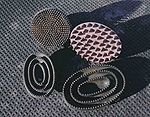
- Curry or Curry comb: A tool made of rubber or plastic with short "teeth" on one side, that slides onto the hand of the groom. It is usually the first tool used in daily grooming. The horse is rubbed or "curried" to help loosen dirt, hair, and other detritus, plus stimulate the skin to produce natural oils. The curry comb is usually used in a circular motion to work loose embedded material. Curries are generally too harsh to be used on the legs or head, though varieties made of softer rubber are available.
- Metal curry comb or Fitch curry comb: The metal curry comb is not designed to use directly on a horse's coat as the metal teeth can damage the skin and hair. It is a curry comb made of several rows of short metal teeth, with a handle. They are primarily designed for use on show cattle, but are frequently used to clean horse grooming brushes by moving the brush across the metal curry comb teeth every few strokes.
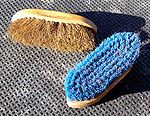
- Dandy brush or Hard-bristled brush: A stiff-bristled brush is used to remove the dirt, hair and other material stirred up by the curry. Brushes are used in the direction of the horse's hair coat growth, usually in short strokes from front to back, except at the flanks, where the hair grows in a different pattern. The best quality dandy brushes are made of stiff natural bristles such as rice stems, though they wear out quickly. Plastic-bristled dandy brushes are more common. Dandy brushes can usually be used on the legs, but many horses object to a stiff brush being used on the head. Some dandy brushes do double duty as a Water Brush, when moistened in water and used to wet down the hair coat, mane or tail. Such use may include creating quarter marksQuarter marksQuarter marks are a type of ornamentation on a horse seen in certain types of exhibition or competition. Typically, these marks are found on the croup of the animal and are created by combing its hair in different directions, creating contrasting areas. The classic design was created by...
for show. - Body brush or Soft brush: A soft-bristled brush removes finer particles and dust, adds a shine to the coat and is soothing to the horse. A body brush, particularly a smaller design called a Face brush, can be used on the head, being careful to avoid the horse's eyes. Some natural body brushes are made of horsehair, goat hair or boar bristles, like human hairbrushes, others are made of soft synthetic fibers. The body brush is generally the last brush used on the horse.
- Grooming rag or towel, also called a Stable rubber: A linen or terrycloth towel or similar type of cloth, or sheepskin mitt, can be used to give a final polish to a horse's coat and is also used after riding to help remove sweat.
- Mane brush or comb: Horses with short, pulled manesMane (horse)The mane is the hair that grows from the top of the neck of a horse or other equine, reaching from the poll to the withers, and includes the forelock or foretop. It is thicker and coarser than the rest of the horse's coat, and naturally grows to roughly cover the neck...
have their manes combed with a wide-toothed plastic or metal comb. Tails and long manes are brushed with either a dandy brush or a suitable human hairbrush. Extremely long show-quality manes and tails are often picked out by hand to avoid breaking the hairs. A short-toothed Pulling comb is used to pull the mane to shorten and thin it in preparation for braiding. - Hoof pick: A hooked tool, usually of metal, used to clean the hoovesHorse hoofA horse hoof is a structure surrounding the distal phalanx of the 3rd digit of each of the four limbs of Equus species, which is covered by complex soft tissue and keratinised structures...
of a horse. Some designs include a small, very stiff brush for removing additional mud or dirt. All four feet of the horse need to be cleaned out before and after riding. {See Picking the feet below.)

- Shedding blade: In special weather conditions, a metal shedding blade with short, dull teeth is used to remove loose winter hair. A shedding blade is also useful for removing caked-on mud. However, grooming tools with metal teeth can split and dull the horse's hair coat and may irritate the skin, so must be used with appropriate care. Likewise, metal grooming tools used on sheep and show cattle may also be too harsh to use on a horse.
- Sweat scraper: Several styles of sweat scraper exist to remove sweat after exertion or water after bathing. One is a simple curved and fluted metal or plastic wand, about 18 inches (45.7 cm) long . Another design is an arc of plastic or rubber attached to a handle, sometimes with two curved blades (one rubber, one metal or plastic) attached back to back. A third design is a flexible curved blade with teeth on one side to use as a shedding blade, and smooth on the other, for use as a sweat scraper.
- Fly spray: In the summer, fly spray is often applied to the horse after grooming. Care must be taken to avoid the eyes and mucous membraneMucous membraneThe mucous membranes are linings of mostly endodermal origin, covered in epithelium, which are involved in absorption and secretion. They line cavities that are exposed to the external environment and internal organs...
s. - Bot knife or Bot brick': used to remove botflyBotflyA botfly is any fly in the family Oestridae, which includes all the members of the former families Cuterebridae, Gasterophilidae, and Hypodermatidae. It is the only family of flies whose larvae live as obligate parasites within the bodies of mammals, with the exception of a few screwworm flies in...
eggs from the horse, which are usually laid on the legs or shoulder. Bot eggs are yellow and roughly the size of a grain of sand, they are clearly visible on dark hair, harder to spot on white hair. A bot knife generally has a blunt end and curved blade and is used to "shave" off the egs. A bot brick is a small pumice stone or block of dense styrofoamStyrofoamStyrofoam is a trademark of The Dow Chemical Company for closed-cell currently made for thermal insulation and craft applications. In 1941, researchers in Dow's Chemical Physics Lab found a way to make foamed polystyrene...
that will pick up eggs when rubbed on the hair. - Scissors: Used to trim long hairs growing under the jaw and the fetlocks, as well as trimming the bridle pathBridle pathA bridle path is a thoroughfare originally made for horses, but which these days serves a wide range of interests, including hikers, walkers and cyclists as well as equestrians. The laws relating to permissions vary from country to country...
or banging the tailTail (horse)The tail of the horse and other equines consists of two parts, the dock and the skirt. The dock consists of the muscles and skin covering the coccygeal vertebrae. The term "skirt" refers to the long hairs that fall below the dock...
. - Clippers: In order to remove a horse's winter coat to allow him to work more comfortably and dry faster in the colder months, larger electric clippers are used. Small clippers are also useful for trimming ears, jawlines and legs. Hand-operated clippers are still available but not often used, since electric clippers are so much more efficient. (See "Clipping" below.)
- Sponges: Small sponges can be used to clean the eyes, nose, lips and, using a separate sponge dedicated to the task, beneath the dock and around the genitals. Larger sponges can be used to wet down and clean the body and legs.
The hoof

Cleaning the feet
The most basic form of hoofcare is cleaning, or picking out the feet. A hoof pick is used to remove mud, manure, and rocks from the sole of the hoof. Removal of mud and manure helps to prevent thrushThrush (horse)
Thrush is a very common bacterial infection that occurs on the hoof of a horse, specifically in the region of the frog. The bacteria occur naturally in the animal's environment—especially in wet, muddy, or unsanitary conditions, such as an unclean stall—and grow best with low oxygen...
, a common hoof ailment which in very severe cases may cause lameness
Lameness (equine)
Lameness in horses and other equidae is a term used to refer to any number of conditions where the animal fails to travel in a regular and sound manner on all four feet...
, and the removal of rocks helps to prevent stone bruises. In the winter, hoof picking also provides the chance to remove packs of snow from the horse's hooves, which can cause uncomfortable "snowballs." Additionally, when the hoof is cleaned, it can be visually inspected for problems such as puncture wounds due to a nail (which has the potential to be very serious if left untreated).

Frog (horse)
The frog is a part of a horse's hoof, located on the underside, which should touch the ground if the horse is standing on soft footing. The frog is triangular in shape, and extends from the heels to mid-way toward the toe, covering around 25% of the bottom of the hoof...
of the hoof, or the person using the pick. When picking the feet, the groom stands at the horse's side, facing the tail of the horse, then slides his or her hand down the horse's leg. If the horse was not trained to pick up its foot when a person runs their hand to the fetlock and lifts lightly, most horses will pick up their feet if the tendons behind their cannon bone are squeezed. Some horses, particularly draft
Draft horse
A draft horse , draught horse or dray horse , less often called a work horse or heavy horse, is a large horse bred for hard, heavy tasks such as ploughing and farm labour...
breeds, may be trained to pick up their feet to pressure on their fetlock
Fetlock
Fetlock is the common name for the metacarpophalangeal and metatarsophalangeal joints of horses, large animals, and sometimes dogs. It is formed by the junction of the third metacarpal or metatarsal bones proximad and the proximal phalanx distad...
.
Most horse management guidelines recommend picking the feet daily, and in many cases, the feet are picked twice in one day, both before and after a ride.
Dressings and polish
Hoof dressing is a liquid substance used on the hooves to improve their moisture content, which in turn helps prevent hoof cracks, lost shoes, tender feet, and other common hoof problems. Polish for hooves is used for show purposes and is either based on formulas similar to either wax-based shoe polish or to enamelized human nail polish.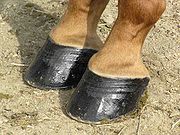
Dressage
Dressage is a competitive equestrian sport, defined by the International Equestrian Federation as "the highest expression of horse training." Competitions are held at all levels from amateur to the World Equestrian Games...
, show hunter
Show hunter
The show hunter is a type of show horse that is judged on its movement, manners, and way of going, particularly while jumping fences. The horses are shown in hunt seat style tack, and are often of Warmblood or Thoroughbred type, though a hunter-style pony is also seen in youth classes...
s, jumpers
Show jumping
Show jumping, also known as "stadium jumping," "open jumping," or "jumpers," is a member of a family of English riding equestrian events that also includes dressage, eventing, hunters, and equitation. Jumping classes commonly are seen at horse shows throughout the world, including the Olympics...
, and eventing
Eventing
Eventing is an equestrian event comprising dressage, cross-country, and show jumping. This event has its roots in a comprehensive cavalry test requiring mastery of several types of riding...
, as well as most breed shows, other than some stock horse
Stock horse
A Stock horse is a horse of a type that is well suited for working with livestock, particularly cattle. Such horses are riding horsescharacterized by agility, quickness, and powerful hindquarters...
breeds. Black polish is seen in the western disciplines, especially western pleasure
Western Pleasure
Western Pleasure is a western style competition at horse shows that evaluates horses on manners and suitability of the horse for a relaxed but collected gait cadence and relatively slow speed of gait, along with calm and responsive disposition. The horse is to appear to be a "pleasure" to ride and...
, but some breeds, notably the Appaloosa
Appaloosa
The Appaloosa is a horse breed best known for its colorful leopard-spotted coat pattern. There is a wide range of body types within the breed, stemming from the influence of multiple breeds of horses throughout its history. Each horse's color pattern is genetically the result of various spotting...
, ban any polish that alters the natural hoof color. Gaited breeds have varying rules, some allowing black polish, others limiting its use. Whether clear or colored, polish is applied purely for aesthetic reasons, as a finishing touch.
Bathing
Horses can be bathed by being wet down with a garden hose or by being sponged off with water from a bucket. Horses do not require bathing and many horses live their entire lives without a bath. However, horses are often hosed off with water after a heavy workout as part of the cooling down process, and are often given baths prior to a horse show to remove every possible speck of dirt. They must be trained to accept bathing, as a hose and running water are unfamiliar objects and initially may frighten a horse. A hose is usually used for bathing. Start near the legs, being careful to point the hose at a downward angle. When spraying the body, be sure to angle the hose so that water doesn't hit the horse in the face. Either horse or human shampoo may be safely used on a horse, if thoroughly rinsed out, and cream rinses or hair conditioners, similar to those used by humans, are often used on show horses. Too-frequent shampooing can strip the hair coat of natural oils and cause it to dry out. Though horses in heavy work, such as racehorses, may be rinsed off after their daily workout, it is generally not advisable to shampoo a horse more than once a week, even in the show season. A well-groomed, clean horse can be kept clean by wearing a horse blanketHorse blanket
A horse blanket or rug is a blanket or animal coat intended for keeping a horse or other equine warm or otherwise protected from wind or other elements. They are tailored to fit around a horse's body from chest to rump, with straps crossing underneath the belly to secure the blanket yet allowing...
or horse sheet.
Clipping
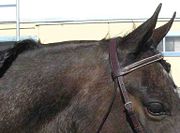
Trimming
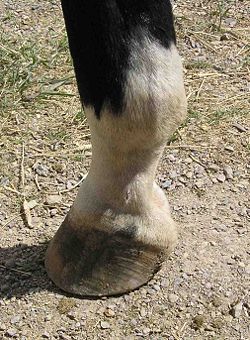
- Bridle pathBridle path (horse)The bridle path is a shaved or clipped section of the mane, beginning behind the ears of a horse at the poll, delineating the area where the crownpiece of the bridle lies...
: a section of mane, just behind the ears, is frequently clipped or shaved off. For practical purposes, this allows the bridleBridleA bridle is a piece of equipment used to direct a horse. As defined in the Oxford English Dictionary, the "bridle" includes both the headstall that holds a bit that goes in the mouth of a horse, and the reins that are attached to the bit....
to lie comfortably on the across the poll, makes it slightly easier to bridle the horse, as the mane and forelock are separated and easier to keep out of the way. The length of the bridle path varies by breed and region of the world: for example, the American SaddlebredAmerican SaddlebredThe American Saddlebred, formerly known as the American Saddle Horse, is a breed of horse that was developed in Kentucky by plantation owners. Today, in the horse show world, they are most commonly seen under saddle in Saddle seat style riding, and in various types of driving, including pleasure...
and the Arabian are commonly shown in the United States with bridle paths that are several inches long, while other breeds (such as the Friesian horseFriesian horseThe Friesian is a horse breed originating in Friesland, Netherlands. Although the breed's conformation resembles that of a light draft horse, Friesians are graceful and nimble for their size. During the Middle Ages, it is believed that the ancestors of Friesian horses were in great demand as war...
) are not permitted to have any bridle path. In the UK and continental EuropeEuropeEurope is, by convention, one of the world's seven continents. Comprising the westernmost peninsula of Eurasia, Europe is generally 'divided' from Asia to its east by the watershed divides of the Ural and Caucasus Mountains, the Ural River, the Caspian and Black Seas, and the waterways connecting...
, bridle paths are generally rather short if clipped at all, though there is variation depending on breed. - Face: There is little real need to clip the face, it is done primarily for aesthetic reasons. The most practical location to clip is under the jaw, to create a more refined appearance and remove excess hair that may interfere with the cavessonNosebandA noseband is the part of a horse's bridle that encircles the nose and jaw of the horse. In English riding, where the noseband is separately attached to its own headstall or crownpiece, held independently of the bit, it is often called a cavesson or caveson noseband...
and throatlatch of the bridleBridleA bridle is a piece of equipment used to direct a horse. As defined in the Oxford English Dictionary, the "bridle" includes both the headstall that holds a bit that goes in the mouth of a horse, and the reins that are attached to the bit....
. The whiskers of the muzzle are commonly shaved in the United States, though not as often in Europe. Some also clip the feelers above and below the eyes. Clipping the whiskers of the muzzle or eyes is a topic of minor controversy, as they are thought to help prevent injury because the horse can "feel" when it is approaching an object. - Ears: The hair on the pinnae (ears) of the horse may be clipped, sometimes both inside and out. The practice of clipping the inside of the ears is also controversial, as the hairs inside the ear protect the inner ear from dirt and insects. When the ears are trimmed on the inside, a fly maskFly maskA fly mask or fly cap is a mask used on horses to cover the eyes, jaw, and sometimes the ears and muzzle to protect from flies. The mask is semi-transparent and made from a mesh allowing the horse to see and hear while wearing it. The mask may also provide some protection from UV-light...
with ear protection is often put on the horse to replace its natural protection. - Legs: The fetlockFetlockFetlock is the common name for the metacarpophalangeal and metatarsophalangeal joints of horses, large animals, and sometimes dogs. It is formed by the junction of the third metacarpal or metatarsal bones proximad and the proximal phalanx distad...
s can collect undesired amounts of mud, dirt, and burrs and may be trimmed for practical reasons. The back of the lower cannonHorse anatomyEquine anatomy refers to the gross and microscopic anatomy of horses and other equids, including donkeys, and zebras. While all anatomical features of equids are described in the same terms as for other animals by the International Committee on Veterinary Gross Anatomical Nomenclature in the book...
is also commonly clipped, also to remove long hairs. For a truly polished look, the coronary band is clipped to shorten the small straggling hairs that grow along the edges of the hoof. Leg clipping is done for most light riding horses. However, there are several breeds, particularly draft horseDraft horseA draft horse , draught horse or dray horse , less often called a work horse or heavy horse, is a large horse bred for hard, heavy tasks such as ploughing and farm labour...
breeds, that consider lower leg feathering to be a breed trait and do not permit the clipping of the fetlocks or "feather" on the lower legs.
Body clipping
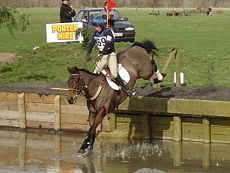
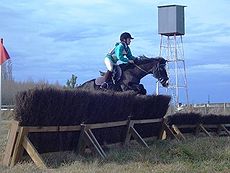
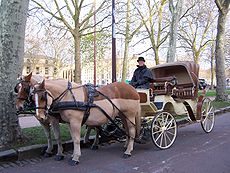
Before one makes the decision to body clip a horse, one must be sure to consider the fact that they are removing the horse's natural defences against the cold. They must therefore be able to provide blanketing, and in some cases, stabling, for the horse if the temperature drops, or if there is a cold rain or snow. This will increase the amount of work needed to keep the horse, as the groom must change the blankets as needed, but it is essential to keep the horse comfortable and healthy.
Types of body clips include:
- Body clip or Full body clip: the horse's entire body is clipped, including the head and legs. This is the most common body clip in the USA, used in many disciplines. It provides the most "natural" clip, resembling a horse's normal summer coat, plus it is a relatively straightforward clip for a groom to complete. However, it provides the least amount of natural protection for the horse.
- Hunter clip: The entire horse is clipped, except for the legs and a patch of hair under the saddle. This clip traces back to the hunt fieldFox huntingFox hunting is an activity involving the tracking, chase, and sometimes killing of a fox, traditionally a red fox, by trained foxhounds or other scent hounds, and a group of followers led by a master of foxhounds, who follow the hounds on foot or on horseback.Fox hunting originated in its current...
, and is still used there today, as it provides extra protection to the back of the horse (essential during several hours of hunting) as well as to the lower legs (which may be cut by brambles), but still allows the horse to stay cool while galloping. - Blanket clip: Long hair is left in a blanket-shaped area on the horse. The shoulders and neck are clipped, the legs are left unclipped.
- Trace clip: varies, but generally the horse is clipped from under its throat, down along the jugular groove, and then clipped half-way up the shoulder and belly. Variations include clipping higher along the neck, shoulder, and belly, and clipping a strip off the side of the hindquarter, to the buttock. Additionally, many clip a strip half-way up the cheek to the muzzle. The back and legs are left unclipped. The clip is named after the traces of the carriage, as it follows a similar pattern. The amount of hair removed is based on the work the horse is in, the amount it sweats during work, and the areas where it sweats the most. It is most commonly seen used by eventersEventingEventing is an equestrian event comprising dressage, cross-country, and show jumping. This event has its roots in a comprehensive cavalry test requiring mastery of several types of riding...
. - Chaser Clip: Hair is removed from a line below the poll to the stifle, legs are left on. This is a popular clip for steeplechasers as it keeps the horses' back warm but also allows for hard work.
- Strip clip or Belly clip: Hair is clipped along the jugular groove, chest and under the barrel. This is a minimal clip, and many horses with this clip do not need extra care beyond regular blanketing.
The mane
The modern horse usually has its mane groomed to fit a particular breed, style, or practical purpose. For informal pleasure ridingPleasure riding
Pleasure riding is a form of equestrianism that encompasses many forms of recreational riding for personal enjoyment, absent elements of competition. Pleasure riding is called "hacking" in British English, and in parts of the eastern United States and Canada...
, the mane is simply detangled with a brush or wide-toothed comb and any foreign material removed.
The mane may be kept in a long, relatively natural state, which is required for show by some breeds, particularly those used in Saddle seat
Saddle seat
Saddle Seat is a style of horseback riding within the category of English riding that is designed to show off the high trotting action of certain horse breeds. The style developed into its modern form in the United States, and is also seen in Canada and South Africa...
style English riding
English riding
English riding is a term used to describe a form of horse riding that is seen throughout the world. There are many variations in English riding, but all feature a flat English saddle without the deep seat, high cantle or saddle horn seen on a Western saddle nor the knee pads seen on an Australian...
competition. A long mane may be placed into five to seven long, relatively thick braids between shows to keep it in good condition, to help it grow, and to minimize debris and dirt from entering. Breeds mandated to show with a long mane keep a long mane in almost all disciplines, even those where show etiquette normally requires thinning or pulling.
In some breeds or disciplines, particularly many Western
Western riding
Western riding is a style of horseback riding which evolved from the ranching and warfare traditions brought to the Americas by the Spanish Conquistadors, and both equipment and riding style evolved to meet the working needs of the cowboy in the American West...
and hunt seat
Hunt seat
Hunt seat is terminology used in the United States and Canada to refer to a style of forward seat riding commonly found at American horse shows. Along with Dressage, it is one of the two classic forms of English riding. The Hunt seat is based on the tradition of fox hunting...
competitions, the mane is thinned and shortened for competition purposes. The most common method of shortening and thinning the mane is by pulling it. Originally a thinned mane was considered easier to keep free of dirt, burrs, and out of the way of the rider, thus worth the time and upkeep of regular thinning. Today, its purpose is primarily for tradition and to make it lay down flat and easier to braid or band.
Horses shown in hunter
Show hunter
The show hunter is a type of show horse that is judged on its movement, manners, and way of going, particularly while jumping fences. The horses are shown in hunt seat style tack, and are often of Warmblood or Thoroughbred type, though a hunter-style pony is also seen in youth classes...
, jumper
Show jumping
Show jumping, also known as "stadium jumping," "open jumping," or "jumpers," is a member of a family of English riding equestrian events that also includes dressage, eventing, hunters, and equitation. Jumping classes commonly are seen at horse shows throughout the world, including the Olympics...
, dressage
Dressage
Dressage is a competitive equestrian sport, defined by the International Equestrian Federation as "the highest expression of horse training." Competitions are held at all levels from amateur to the World Equestrian Games...
, eventing
Eventing
Eventing is an equestrian event comprising dressage, cross-country, and show jumping. This event has its roots in a comprehensive cavalry test requiring mastery of several types of riding...
and related hunt seat
Hunt seat
Hunt seat is terminology used in the United States and Canada to refer to a style of forward seat riding commonly found at American horse shows. Along with Dressage, it is one of the two classic forms of English riding. The Hunt seat is based on the tradition of fox hunting...
and show hack
Show hack
The show hack is a type of ridden show horse, exhibited to a standard first established in England.Affiliated showing and breeding of the show hacks in the United Kingdom is overseen by the British Show Horse Association....
disciplines usually have their manes not only shortened and thinned, but placed into many individual braids for show. Heavier breeds of horses, particularly draft horse
Draft horse
A draft horse , draught horse or dray horse , less often called a work horse or heavy horse, is a large horse bred for hard, heavy tasks such as ploughing and farm labour...
s, may have their manes french braid
French braid
A French braid, or French plait, is a type of braided hairstyle.-Description:Unlike the simplest form of three-strand braid, in which all of the hair is initially divided into three sections which are simultaneously gathered together near the scalp , a French braid starts with three small sections...
ed instead of being pulled, thinned and placed in individual braids. Breeds required to show with long manes may also french braid the mane if an animal is cross-entered in both a breed and a hunter/jumper discipline.
The mane may also be "roached" or "hogged", meaning that it is completely shaved off. This is most commonly seen in polo
Polo
Polo is a team sport played on horseback in which the objective is to score goals against an opposing team. Sometimes called, "The Sport of Kings", it was highly popularized by the British. Players score by driving a small white plastic or wooden ball into the opposing team's goal using a...
ponies, Australian Stock Horse
Australian Stock Horse
The Australian Stock Horse , has been especially bred for Australian conditions. It is a hardy breed of horse noted for endurance, agility and a good temperament. Its ancestry dates to the arrival of the first horses in Australia, brought from Europe, Africa and Asia...
s and roping
Calf roping
Calf roping, also known as tie-down roping, is a rodeo event that features a calf and a rider mounted on a horse. The goal of this timed event is for the rider to catch the calf by throwing a loop of rope from a lariat around its neck, dismount from the horse, run to the calf, and restrain it by...
horses, to keep the mane out of the rider's way, and to prevent the mallet or rope from becoming entangled.
The tail



In show grooming, the dock of the tail (the flesh-covered part of the tail where the hair is rooted) and the "skirt" (the hair below the tip of the dock) may be styled in a wide variety of ways: The tail may be kept natural and encouraged to grow as long as possible, and sometimes even has additional hair artificially attached. Other times, it may be clipped, thinned, or even cut very short. A few breeds are shown with docked
Docking (animal)
Docking is a term for the intentional removal of part of an animal's tail or ears. The term cropping is also used, though more commonly in reference to the cropping of ears, while docking more commonly—but not exclusively—refers to the tail. The term tailing is also commonly used...
tails.
A "natural" tail is not clipped nor braided when the horse is presented in the ring. The tail may be encouraged to grow as long as possible, often by keeping the skirt of the tail in a long braid when not in competition, usually also folded up and covered by a wrap to keep it clean. The shorter hairs of the dock are allowed to hang loose so that the horse can still swat flies. "Natural" tails can also be thinned and shaped by pulling hairs at the sides of the dock, or by pulling the longest hairs in the skirt of the tail, to make the tail shorter and less full, though retaining a natural shape.
Tail hairs are also cut. "Clipping" the tail usually refers to trimming the sides of the dock, to a point about halfway down the dock. Banging the tail involves cutting the bottom of the tail straight at the bottom. In modern competition, this is usually done well below the hocks. On the other hand, Tail extensions, also known as "false tails," or "tail wigs," are false hairpieces which are braided or tied into the tail to make it longer or fuller.
Braiding the dock of the tail in a French braid
French braid
A French braid, or French plait, is a type of braided hairstyle.-Description:Unlike the simplest form of three-strand braid, in which all of the hair is initially divided into three sections which are simultaneously gathered together near the scalp , a French braid starts with three small sections...
with the skirt left loose is commonly seen in hunter
Show hunter
The show hunter is a type of show horse that is judged on its movement, manners, and way of going, particularly while jumping fences. The horses are shown in hunt seat style tack, and are often of Warmblood or Thoroughbred type, though a hunter-style pony is also seen in youth classes...
competition and hunt seat equitation
Equitation
Equitation is the art or practice of horse riding or horsemanship.More specifically, equitation may refer to a rider's position while mounted, and encompass a rider's ability to ride correctly and with effective aids. In horse show competition, the rider, rather than the horse is evaluated...
. In polo
Polo
Polo is a team sport played on horseback in which the objective is to score goals against an opposing team. Sometimes called, "The Sport of Kings", it was highly popularized by the British. Players score by driving a small white plastic or wooden ball into the opposing team's goal using a...
, draft horse showing
Draft horse showing
Draft horse showing refers to horse shows exclusively for horses of the draft horse breeds. In North America, though a small number of draft horses are also shown under saddle, the term "Draft horse showing" refers to a specific horse show competition that primarily features driving exhibitors...
and on Lipizzan
Lipizzan
The Lipizzan or Lipizzaner , is a breed of horse closely associated with the Spanish Riding School of Vienna, Austria, where the finest representatives demonstrate the haute école or "high school" movements of classical dressage, including the highly controlled, stylized jumps and other movements...
horses that perform the capriole, the entire tail, dock and skirt, is generally braided and the braid is folded or rolled into a knot, with or without added ribbons and other decorative elements. In inclement weather, many other show disciplines will allow competitors to put up the skirt of the tail into a similar type of stylized knot known as a mud tail.
In the draft horse
Draft horse
A draft horse , draught horse or dray horse , less often called a work horse or heavy horse, is a large horse bred for hard, heavy tasks such as ploughing and farm labour...
and some harness breeds the tail is cut very short to keep it from being tangled in a harness
Horse harness
A horse harness is a type of horse tack that allows a horse or other equine to pull various horse-drawn vehicles such as a carriage, wagon or sleigh. Harnesses may also be used to hitch animals to other loads such as a plow or canal boat....
. The term "docked" or "docking" may simply mean cutting the hair of the tail skirt very short, just past the end of the natural dock of the tail. However, it can also refer to partial tail amputation
Amputation
Amputation is the removal of a body extremity by trauma, prolonged constriction, or surgery. As a surgical measure, it is used to control pain or a disease process in the affected limb, such as malignancy or gangrene. In some cases, it is carried out on individuals as a preventative surgery for...
. This type of docking is banned in some places, and either type of docking can make it difficult for a horse to effectively swat flies. Another controversial practice, tail setting, involves placing the dock of the tail in a device that causes it to be carried at all times in an arched position desired for show. The set is used when the horses are stalled, and removed during performances. It stretches the muscles to keep the tail in position, and is not used after the horse is retired from competition. Sometimes the process is sped up by the controversial practice of nicking or cutting the check ligament that normally pulls the tail downward. This practice is generally only used for a few breeds, such as the American Saddlebred
American Saddlebred
The American Saddlebred, formerly known as the American Saddle Horse, is a breed of horse that was developed in Kentucky by plantation owners. Today, in the horse show world, they are most commonly seen under saddle in Saddle seat style riding, and in various types of driving, including pleasure...
.
Highlighter
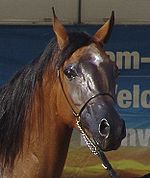
Neck sweats
Neck sweats are wraps, usually of neopreneNeoprene
Neoprene or polychloroprene is a family of synthetic rubbers that are produced by polymerization of chloroprene. Neoprene in general has good chemical stability, and maintains flexibility over a wide temperature range...
, placed on the neck or jowl of the horse to cause it to sweat. This is a short-term method that will temporarily reduce a thick jowl or cresty neck, to make it appear finer in appearance. This tool is used both by breeds prone to heavy necks who benefit from some slimming, but also by breeds with refined necks to create a more extreme refinement, often called a "hooky" neck.
Coat treatments
A number of products, usually in spray form, have been developed to add extra gloss, smoothness or shine to a coat. Some sprays are oil-based, but because they attract dust, more common coat enhancement sprays are oil-free, often called "siliconeSilicone
Silicones are inert, synthetic compounds with a variety of forms and uses. Typically heat-resistant and rubber-like, they are used in sealants, adhesives, lubricants, medical applications , cookware, and insulation....
" sprays, that leave the hair coat very smooth and slick. Most are applied to the horse after it has been bathed and dried, though are occasionally used on a horse that has not been bathed to add a quick gloss for short-term purposes, such as a photograph.

